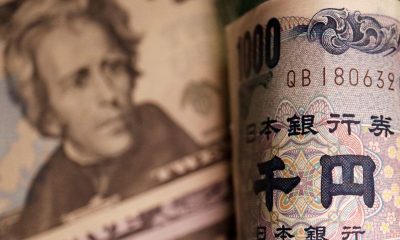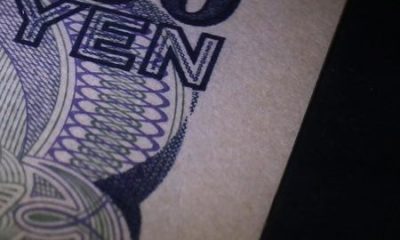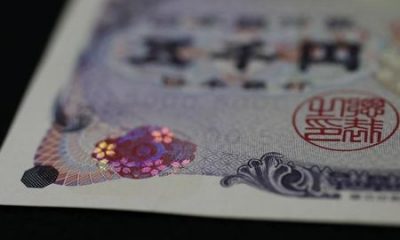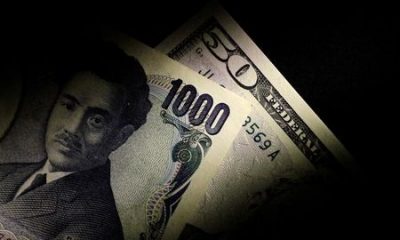Economy
Fed’s Mester sees another rate hike, says rate cuts may have to wait
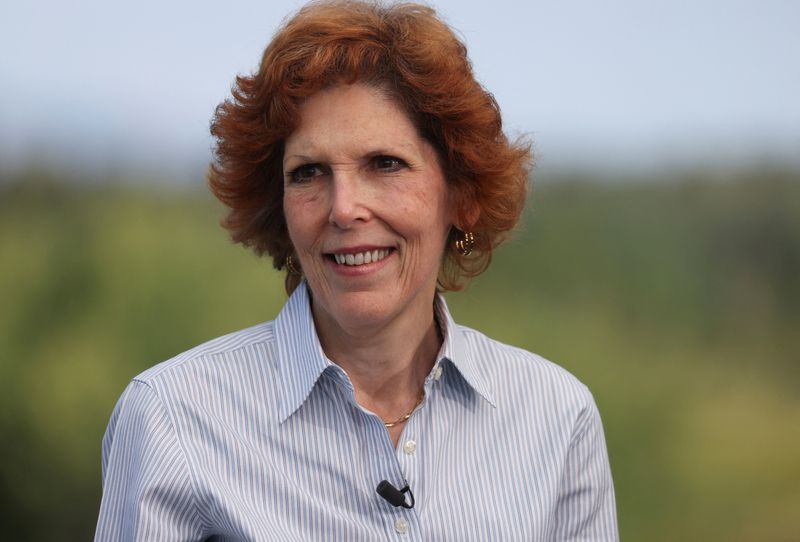
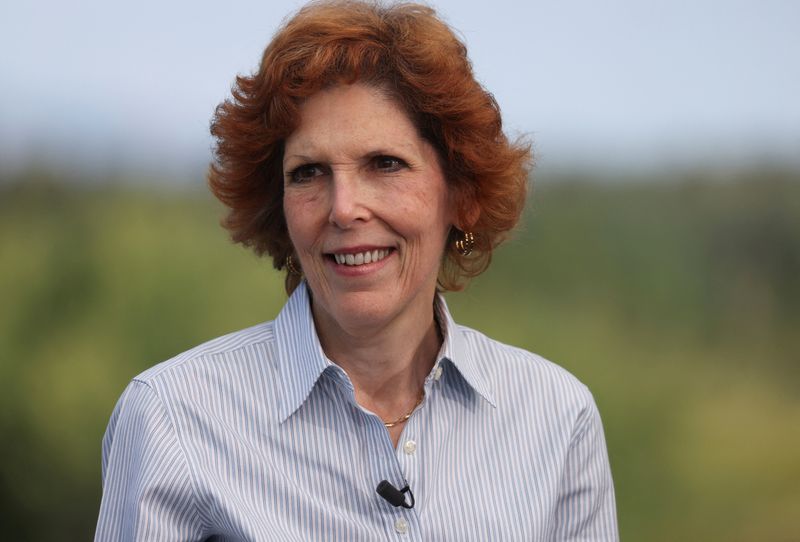
© Reuters. Loretta J. Mester, president and CEO of the Federal Reserve Bank of Cleveland, looks on at Teton National Park where financial leaders from around the world gathered for the Jackson Hole Economic Symposium outside Jackson, Wyoming, U.S., August 26, 2022.
By Ann Saphir and Howard Schneider
JACKSON HOLE, WYOMING (Reuters) – Beating inflation will probably require one more U.S. interest-rate hike and then going on hold for “a while,” Cleveland Federal Reserve Bank Loretta Mester said on Saturday, adding that she may reassess her earlier view that rate cuts could start in late 2024.
While she does not want policy so tight that the economy collapses, she told Reuters in an interview on the sidelines of a Fed conference in Jackson Hole, Wyoming, she wants to set it so that inflation reaches the Fed’s 2% goal by the end of 2025.
“We just don’t want it to keep drifting farther out,” she said. Not only do fast-rising prices impose a high cost on Americans, she said; allowing inflation to fester also leaves the economy more vulnerable to future shock.
“The longer we let inflation remain above 2%, we’re building in a higher and higher price level,” she said, and that hurts American households. “And I think that’s why timely matters to me.”
Most Fed policymakers, including Mester, thought in June that they will probably be able to stop hiking once they get the policy rate to the 5.5%-5.75% range, which is one quarter-point higher than it is today.
They also thought that by next year the Fed will likely begin cutting rates so that as inflation falls, they do not end up restricting the economy more than is needed.
Mester said on Saturday that in June she also had penciled in rate cuts in the second half of 2024, but that when she and other Fed policymakers submit fresh forecasts ahead of their September rate-setting meeting, that might change.
“I’m going to have to reassess that because, again, it’s going to be, how quickly do you think inflation is moving down?” she said.
Economic growth has been more robust than many have expected, and the labor market is still tight, and Mester does believe that the Fed’s rate hikes so far will moderate the strength of both.
Still, she is wary of assuming that inflation, having dropped to 3% from its peak last year of 7%, will get back down to 2% in a timely enough manner.
“I do not want to be in a position of prematurely loosening policy,” Mester said.
Fed projections submitted in June show a median forecast for 2.1% inflation by the end of 2025; Mester said hers was for 2% inflation. Forecasts submitted in September will show what they expect through 2026.
As she runs the numbers for her own September forecasts, she said, getting to 2% inflation by the end of 2025 is not a “hard stop” and she could conceivably push it out if looks like doing so would hurt the economy too much.
But that is not what she expects at this point.
“Given where we are and given where inflation is, I think we have a good shot about bringing inflation down to 2% without doing damage to the real side of the economy,” Mester said.
“I’m going to calibrate my policy to make sure that we’re back in that time frame (of 2% inflation by 2025).”
The Fed’s next and possibly last rate hike “doesn’t necessarily have to be September, but I think this year,” she said.
Economy
Russian central bank says it needs months to make sure CPI falling before rate cuts -RBC


© Reuters. Russian Central Bank Governor Elvira Nabiullina attends a news conference in Moscow, Russia June 14, 2019. REUTERS/Shamil Zhumatov/File Photo
MOSCOW (Reuters) – Russia’s central bank will need two to three months to make sure that inflation is steadily declining before taking any decision on interest rate cuts, the bank’s governor Elvira Nabiullina told RBC media on Sunday.
The central bank raised its key interest rate by 100 basis points to 16% earlier in December, hiking for the fifth consecutive meeting in response to stubborn inflation, and suggested that its tightening cycle was nearly over.
Nabiullina said it was not yet clear when exactly the regulator would start cutting rates, however.
“We really need to make sure that inflation is steadily decreasing, that these are not one-off factors that can affect the rate of price growth in a particular month,” she said.
Nabiullina said the bank was taking into account a wide range of indicators but primarily those that “characterize the stability of inflation”.
“This will take two or three months or more – it depends on how much the wide range of indicators that characterize sustainable inflation declines,” she said.
The bank will next convene to set its benchmark rate on Feb. 16.
The governor also said the bank should have started monetary policy tightening earlier than in July, when it embarked on the rate-hiking cycle.
Economy
China identifies second set of projects in $140 billion spending plan


© Reuters. FILE PHOTO: Workers walk past an under-construction area with completed office towers in the background, in Shenzhen’s Qianhai new district, Guangdong province, China August 25, 2023. REUTERS/David Kirton/File Photo
SHANGHAI (Reuters) – China’s top planning body said on Saturday it had identified a second batch of public investment projects, including flood control and disaster relief programmes, under a bond issuance and investment plan announced in October to boost the economy.
With the latest tranche, China has now earmarked more than 800 billion yuan of its 1 trillion yuan ($140 billion) in additional government bond issuance in the fourth quarter, as it focuses on fiscal steps to shore up the flagging economy.
The National Development and Reform Commission (NDRC) said in a statement on Saturday it had identified 9,600 projects with planned investment of more than 560 billion yuan.
China’s economy, the world’s second largest, is struggling to regain its footing post-COVID-19 as policymakers grapple with tepid consumer demand, weak exports, falling foreign investment and a deepening real estate crisis.
The 1 trillion yuan in additional bond issuance will widen China’s 2023 budget deficit ratio to around 3.8 percent from 3 percent, the state-run Xinhua news agency has said.
“Construction of the projects will improve China’s flood control system, emergency response mechanism and disaster relief capabilities, and better protect people’s lives and property, so it is very significant,” the NDRC said.
The agency said it will coordinate with other government bodies to make sure that funds are allocated speedily for investment and that high standards of quality are maintained in project construction.
($1 = 7.1315 renminbi)
Economy
Russian central bank says it needs months to make sure CPI falling before rate cuts -RBC


© Reuters. Russian Central Bank Governor Elvira Nabiullina attends a news conference in Moscow, Russia June 14, 2019. REUTERS/Shamil Zhumatov/File Photo
MOSCOW (Reuters) – Russia’s central bank will need two to three months to make sure that inflation is steadily declining before taking any decision on interest rate cuts, the bank’s governor Elvira Nabiullina told RBC media on Sunday.
The central bank raised its key interest rate by 100 basis points to 16% earlier in December, hiking for the fifth consecutive meeting in response to stubborn inflation, and suggested that its tightening cycle was nearly over.
Nabiullina said it was not yet clear when exactly the regulator would start cutting rates, however.
“We really need to make sure that inflation is steadily decreasing, that these are not one-off factors that can affect the rate of price growth in a particular month,” she said.
Nabiullina said the bank was taking into account a wide range of indicators but primarily those that “characterize the stability of inflation”.
“This will take two or three months or more – it depends on how much the wide range of indicators that characterize sustainable inflation declines,” she said.
The bank will next convene to set its benchmark rate on Feb. 16.
The governor also said the bank should have started monetary policy tightening earlier than in July, when it embarked on the rate-hiking cycle.

 Forex2 years ago
Forex2 years agoForex Today: the dollar is gaining strength amid gloomy sentiment at the start of the Fed’s week

 Forex2 years ago
Forex2 years agoHow is the Australian dollar doing today?

 Forex1 year ago
Forex1 year agoUnbiased review of Pocket Option broker

 Forex2 years ago
Forex2 years agoDollar to pound sterling exchange rate today: Pound plummeted to its lowest since 1985

 Cryptocurrency2 years ago
Cryptocurrency2 years agoWhat happened in the crypto market – current events today

 World2 years ago
World2 years agoWhy are modern video games an art form?

 Stock Markets2 years ago
Stock Markets2 years agoMorgan Stanley: bear market rally to continue

 Economy2 years ago
Economy2 years agoCrude oil tankers double in price due to EU anti-Russian sanctions

